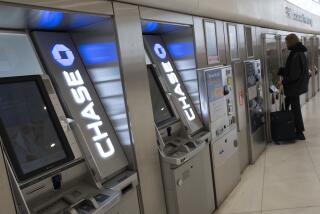Small Savers Get a Chance to Earn More : Minimums Cut on Money-Market and Super Now Accounts
- Share via
Without much fanfare, many of the nation’s banks and savings and loans on Wednesday began offering small depositors the opportunity for higher interest rates on savings and checking accounts.
Small savers, thanks to a new banking regulation that went into effect on Jan. 1, now need maintain a balance of only $1,000 in order to receive market rates of interest on money-market accounts, Super Now checking accounts and time deposits of between seven and 31 days. The minimum had been $2,500.
The rule change is the latest installment in the gradual deregulation of the nation’s banking industry. Next Jan. 1, even the $1,000 minimum balance will be eliminated. Previously, savers unable to maintain the $2,500 minimum could earn an interest rate of 5.5% on their passbook accounts, well below the prevailing bank money-market rate of 7.7% to 8.7%.
New Rule Optional
The new rule is optional, however, and industry surveys indicate that many large financial institutions are keeping at least some of the $2,500 minimums. As a result, savers seeking higher rates will facing a wide and bewildering range of choices that will vary both by institution and by account.
In California, for example, Bank of America has lowered the minimum to $1,000 on its Super Now account but is keeping the $2,500 minimum on its money-market account.
(Money-market accounts are savings accounts with limited check-writing privileges, while Super Now accounts generally offer unlimited checking.)
San Francisco-based Wells Fargo Bank is doing the exact opposite. Effective March 1, it will drop the minimum to $1,000 on its money-market account but keep the Super Now minimum at $2,500.
On the other hand, Los Angeles-based Security Pacific National Bank hasn’t done anything yet.
“We’re still studying the issue,” a spokeswoman explained.
Then there’s Great Western Financial Corp. in Beverly Hills, which has cut its minimum to $1,000 on both the money-market and Super Now accounts.
“We want to be competitive with the small savers as well as the large ones,” explained Great Western Chairman James Montgomery.
The differing reactions to the rule change apparently prevail across the country.
Bank Rate Monitor, a Miami-based newsletter, said 21 financial institutions surveyed last week said that they would lower the minimums on their money-market accounts, while 20 said they would not.
However, the same survey showed that 15 institutions said they would drop the minimums on the Super Now accounts, while 26 said they would not.
Though the reduced minimums are a boon for savers, they are double-edged swords for lenders, industry officials say. They should attract new funds from small savers but they also should increase the cost of money because some new accounts will come from the old 5.5% passbook accounts. An estimated $250 billion to $300 billion remains in these low-yielding accounts at the nation’s banks and S&Ls.;
As a result, only a handful of financial institutions around the country are actively promoting the new accounts, said Gail Liberman, editor of the Bank Rate Monitor.
More to Read
Inside the business of entertainment
The Wide Shot brings you news, analysis and insights on everything from streaming wars to production — and what it all means for the future.
You may occasionally receive promotional content from the Los Angeles Times.










